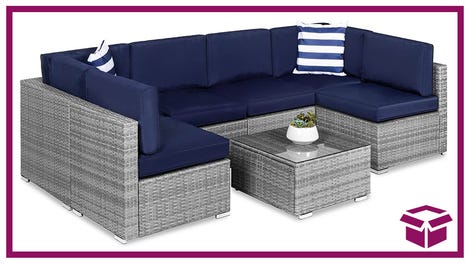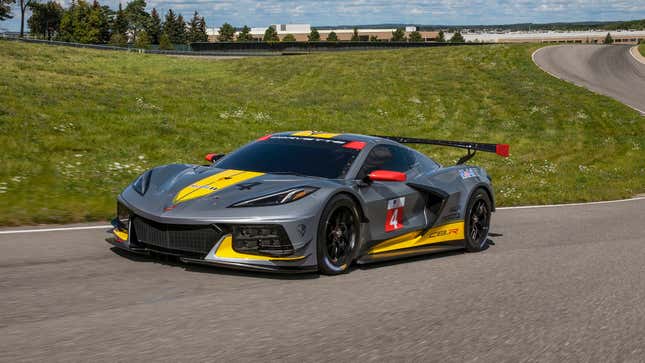
When it first showed the 2020 Corvette C8, Chevy was proud of its magnetic shocks, aluminum suspension, choice 19-inch wheels, and big 6.2-liter V8. But when it comes to the actual race car, you won’t find any of that stuff. Everything gets smaller and simpler. Well, except for the gas tank.
Chevy pulled the covers off its C8.R race car at the Kennedy Space Center a couple of weeks ago, but didn’t share too much other than the aero and livery that was visible. Luckily, they brought a group of us down to Road Atlanta where they gave us a better look at what they’re bringing to the table to battle in IMSA and at Le Mans next year.
The biggest surprise of the technical presentation was the new 5.5-liter DOHC flat-plane crank V8 engine that powers the race car. This engine will not only power the race car but as we shared with you last week will also show up in some form in street car due to FIA homologation rules.
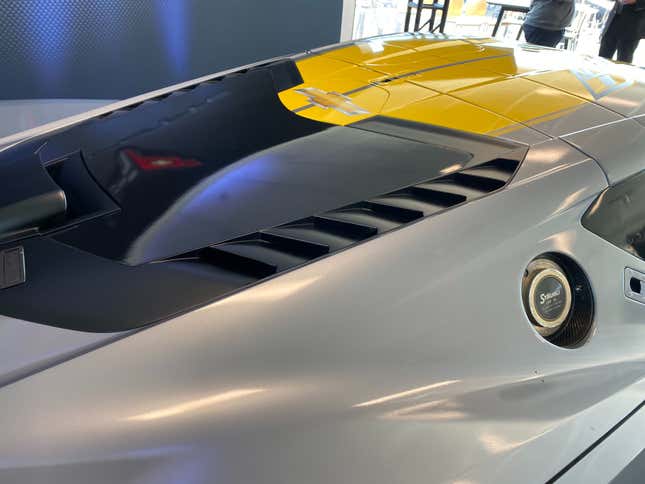
As we noted earlier, the new engine is set at 5.5 liters of displacement as that is the maximum allowed per the FIA rules. It is equipped with dual overhead camshafts, a big departure from the cam-in-block design of their previous race engines that are based on the LS series, not to mention the road car’s 6.2-liter displacement.
Along with the new camshafts, a flat-plane crankshaft completes the package and gives the car a new signature sound. Although we will miss the throaty sound of the pushrod LS7-based C7.R engine, this new engine has a powerful note that still separates it from others in its class.
According to the chief engineer for the Corvette, Ed Piatek, the choice to go with the flat-plane crankshaft allowed them to move the weight in the engine a little lower along with the usual benefit of being able to set a much higher rev limit. Piatek added that the engine will be direct-injected much like their recent street car engines and the most recent variant of the C7.R engine.
Output is estimated at 500 horsepower and 480 pound-feet of torque, which may seem like only a small improvement over the specs for the LT2 pushrod engine in the street car, but it does not represent the full capability of the engine. Those figures are based on the “Balance of Performance” rules for the class which attempt to equalize the competition by requiring a restrictor to be placed in the intake of the engine to reduce the output.

Although it eventually ends up hitting that mandated restrictor, the inlet for the race car has been optimized to get as much fresh air as possible and juts out from the bottom of the hatch to catch the air coming over the roof. The airflow from the roof is pointed in that direction from an area of the hood and roof that Chevy designer Vlad Kapitonov calls the “reverse mohawk” due to its long and indented shape.
The race car will be equipped with a little more fuel capacity than the street car. It has dual saddle tanks like the regular C8, but also has a third tank in the tunnel that runs down the middle of the car. The factory saddle tanks provide for 70 liters of fuel capacity, but that’s not enough for a full stint in IMSA racing as most competitors are allowed between 91 and 95 liters of fuel capacity per the “Balance of Performance” tables.
Based on that we can deduce that the tank in the tunnel can likely hold a little over 25 liters of fuel which converts to right around 7 gallons.
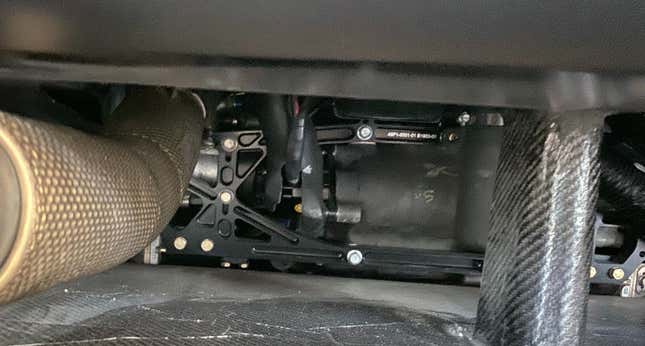
As with most race cars in this class, the road going transmission is replaced by a sequential box that is a better fit for race duty. In this case, Chevy worked with Xtrac to develop a six-speed unit that is compact and pushed closer to the engine to allow for the large diffuser that we see jutting out from the rear of the race car.

Although the race car doesn’t have a large increase in power over the street car it will get around a track much faster and aerodynamic aids such as that diffuser play a large role in the improvements. Along with the rear diffuser, the race car also receives a new splitter that takes the ridge seen in the middle of the C7.R to the extreme and adds strakes to the bottom to better channel air to the rear.
We couldn’t get an exact number on downforce produced by the new car which is not surprising as that’s something that’s not usually shared in a competitive environment but Chevy did share that the C8.R produces around ten percent more downforce than the C7.R.
Although it does have some wild aero, the race car is not far off in some dimensions from the street car. They share a 107.2-inch wheelbase as well as a 182.3-inch length. On the other hand, the race car is 4.6 inches wider and 3.4 inches lower than the production C8.
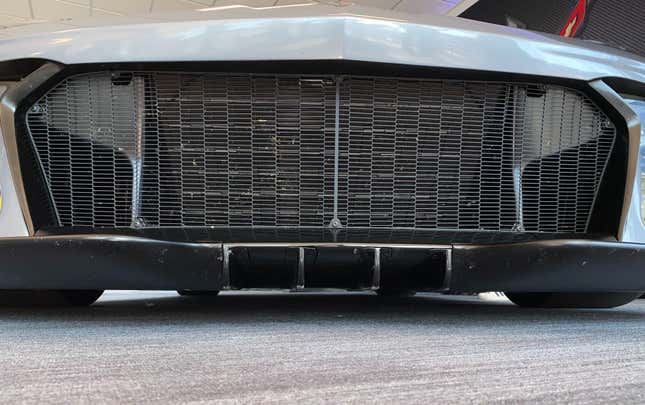
Since the race car doesn’t need to carry any cargo, the front trunk has been filled with a v-mounted radiator. That’s a radiator that’s slanted rather than upright, to get a large radiator under a low hood. It also allows the corners of the front bumper to be filled with lights instead of vents. This helps improve aero and visibility for the race car as well as posing a lesser risk for loss of cooling if there is an impact on either front corner. That large grille in the front is separated into three sections with the radiator getting the bulk of the airflow in the middle and the sides partially blocked in the upper corners with brake ducts in the lower edges.
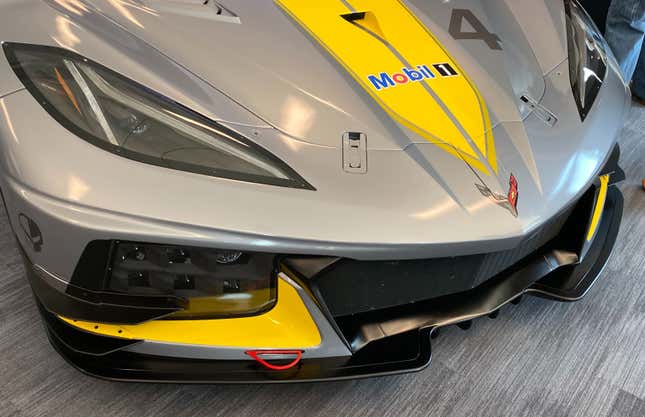
The race car does share a lot with the street car when it comes to what’s underneath that bodywork as both start with the same aluminum chassis. The basis of the chassis are six large die-cast aluminum structures (as covered in detail by David Tracy a few months ago) which are supplemented with aluminum extrusions and stampings that make the C8.R chassis more rigid than the one in the outgoing car.
There are around 150 extrusions, castings, and stampings that make up the road car and according to Engineering Group manager Ed Moss, around 80 of those structural parts are carried over directly from the street car to the race car. The pieces that aren’t carried over are mostly at the very front of the car as the race car has a custom nose cone. Of course, the race car gets a few modifications to the cabin section as they attach a roll cage for safety.
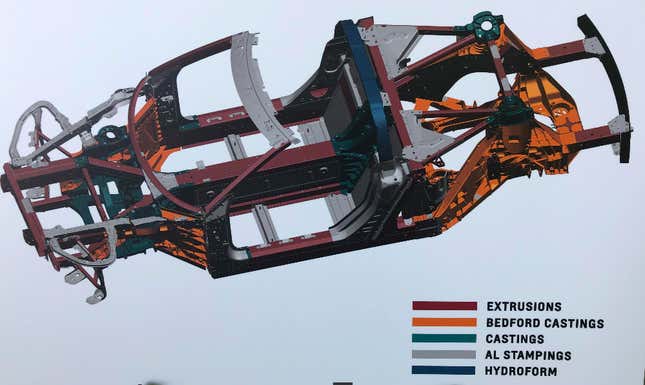
Moving the engine from the front to the rear allows the new race car to take advantage of the physics of having more weight over the driven axle which should make it easier for their drivers to take the car a little faster around a race track than the C7.R. Not only is the weight shifted more towards the rear now but the overall weight of the C8.R is lower than than the C7.R.
This may not seem significant on its own as the FIA and IMSA require a minimum weight for the class, but it is when you consider that the engineers will now have a choice of where to place ballast on the car for better balance.
According to Piatek, there was a significant process in developing the suspension for this car as it is different than anything they’ve done in the past for the Corvette. They were able to work together with the race car group at Pratt & Miller to develop the road car and the street car in parallel.
He also stated that while it took some feedback from their professional drivers to get to the current version of the race car, they were almost immediately faster in the new car and said how much easier it was to turn and how much later they could brake just because of the better weight transfer.

Like the C7.R, the C8.R gets much larger brakes than the street variant. Front rotors measure in at 15.35 inches in diameter which makes them around two inches larger than what you’ll find on a Z51 package street car. The race-spec monoblock calipers increase the piston count in the front from four to six.
The steel rotors are also thicker in the front and rear with race-specific venting to help dissipate heat better. Aluminum hats are used for those rotors to save weight.

The wheels on the race car are an inch smaller in diameter than what you’ll find on that Z51 street car but are much wider to compensate for the large Michelin rubber. The fronts come in at 18 x 12.5 inches while the rears are slightly wider at 18 x 13 inches. They are wrapped in race compound Michelin Pilot Sport tires that come in at 30/68-18 spec in the front and 31/71-18 spec in the rear.
One place where the race car ditches the aluminum is in some of the suspension arms. Instead of the forged aluminum upper control arms and cast-aluminum lower control arms, the race car employs fabricated steel upper and lower control arms. This is not unusual for durability at this level of racing and is a continuation of the materials and methods used in the C7.R. This double-wishbone arrangement is commonly called a short/long-arm (SLA) arrangement as the upper control arms are slightly shorter than the lower control arms which helps to induce negative camber as the suspension moves.
The magnetorheological dampers from the street car are not used on the race which is to be expected as the adjustable coil-over dampers seen on the race car are a better fit for race duty. These cars don’t require the comfort features of the street car and benefit from the wide range of adjustment on those race-spec coilovers.
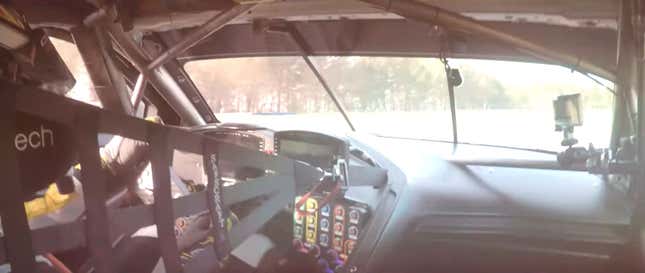
We only got a small peek at the interior when we were at Road Atlanta but Corvette Racing shows a little more in a recent promo video that was released. We see that the street car dash shape is retained for the most part, including the large separator to the right of the driver that houses a variety of switches.
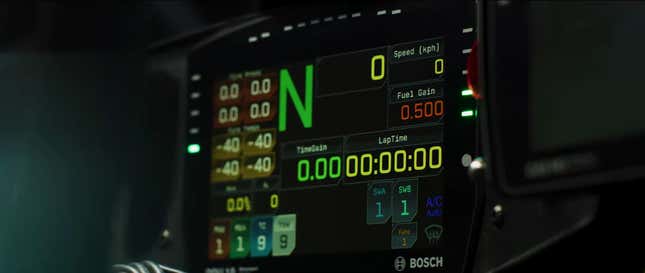
A Bosch digital dash is employed for the stats that the drivers look at along with a Bosch camera display in the middle which shows the driver what’s behind the car and what type of competitor is approaching. Like the C7.R, the C8.R has a steering wheel that flips up to make driver changes faster.

All in, the C8.R is an interesting look at how rules dictate how a modern race car comes out—as well as how some of the tech we see meant for road duty isn’t necessarily more useful when you’re running a race program. There, you want toughness, lightness, and simplicity as much as possible.
